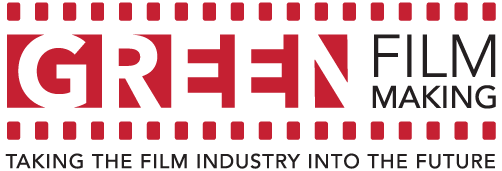Artikelen
Alle artikelen die GFM in de laatste 10 jaar heeft
geschreven over duurzaamheid in de filmwereld.
Categories
Archives
5 Green Filmmaking Tips By Bas Andries
Mar 21, 2013 | Technical
Bas Andries (left) and Bart van Tunen, demonstrating a new energy efficient led lamp for use on film sets. Bas Andries works as a director of photography. On the set he leads the lighting and camera departments, but he also collaborates with the director and the production designer during the shoots. Determining the best light is one of the main issues in his work. Currently he is working on a film in post-production. Last summer he worked on an LA film called ‘Cats dancing on Jupiter’.
We asked him about his take on green film making. From the interview we’ve composed a top 5 list of his green film making solutions:
1. Use an efficient energy source. Rather than using a generator, opt for sustainable led lamps if possible. Bas Andries is currently working on bringing a special type of sustainable led lamp from the US to the Netherlands. To give you an example: this lamp uses 130W and almost produces the same amount of light a regular filmlamp uses, which in turn consumes 1000W (1kW). Keep on the lookout!
2. On remote locations, try to use efficient and green energy sources, like solar power.
3. Why not re-use vintage cameras? We’re so accustomed to using the latest gadgets, that we barely make use of older technology.
4. Don’t throw out old decor/set pieces or props. Re-use them (store them somewhere and save costs by using shared spaces) or rent them.
5. Be innovative, green solutions doesn’t have to mean higher budget! Get creative, get everyone on the set involved, plan ahead and work efficiently with your team.
Must-have Apps For Moviemakers
Mar 20, 2013 | Technical
Scouting through the web for more information on ways to save paper during filmproduction, we found this very usefull list from Moviemakers.com: the best apps in 2011 for moviemakers!! From callsheet to artboards and storyboard composers, it’s all there!
(Still from stop-motion film by Bang-yao Liu)
100% Recycled Footage
Mar 19, 2013 | Technical
In looking for new ways to make film productions more sustainable, there’s a very revolutionary approach not everyone will consider..and it’s because it doesn’t actually involve filming at all! (producers keep your ears covered) By using 100% stock footage and public domain video’s, you can come a very long way. Think about it: no shooting scenes, no energy wasting…just editing and using what’s already there. If not for a complete movie you can certainly use recycled footage in between new scenes and still keep your artistic integrity. Seriously, all the big producers are doing it 😉
Get inspired by Nike’s Better World Campaign, which consists entirely out of older, recycled ads. Do you have any inspirational examples of recycled footage? Share them on our #GFMC community!
The Clapperboard App
Mar 18, 2013 | Technical
This has got to be one of the most handy apps
available to filmmakers; it’s called MovieSlate and it’s a Clapperboard & Shot Log tool.
What does it do? It gets quick references to shots you need, without wading through hours of footage. Each shot, all production, GPS location, and timecode data is stored to a Shot Log History, where you can view,
edit, or ★-rate shots. From the app, you can search/sort History by: production, roll, scene, or take; and sort by date/time, or star-rating. History and Notes can be emailed in HTML, CSV, tab-delimited, and FinalCut XML formats.
(Picture by Gary Knight)
Second Line Stages
Mar 17, 2013 | Art Department, Production
Second Line Stages is the first green, Independently owned film studio in the United States! It is located in the Lower Garden District of New Orleans and it has three sound stages, an office space, a flex space, and a digital theater. Second Line Stages has been built to comply with the LEED Silver Certification from the US Green Building Council. Read their very inspirational story here.
The film ‘the Green Lantern’, now just out in theatres, was one of the first movies to be sustainably filmed there.
What’s so green about them, you ask? Well, you can read more about all their achievements so far here, which are quite a lot!
Folly For A Flyover
Mar 16, 2013 | Innovations
Props for this amazing idea of a pop-up cinema event called ‘Folly for a Flyover.’ The cinema is built from the ground up with local, reclaimed and donated materials. It’s hidden beneath a traffic intersection. Just last year, non-profit collective Assemble transformed a petrol station into a hand-built cinema.
With Folly, their next braindchild, they have screenings lined up ranging from classic films to experimental features, some of them accompanied by live scores, light shows and performances. Watch the building process here.
Like a giant construction-kit, the folly will be built over the period of a month by a team of volunteers. Having served one purpose it will be disassembled at the end of the summer, and the compents will find new uses across the local area.
It’s a great inspiration for filmmakers, showing that it’s possible to create a sustainable venue, or rather, something out of nothing!






